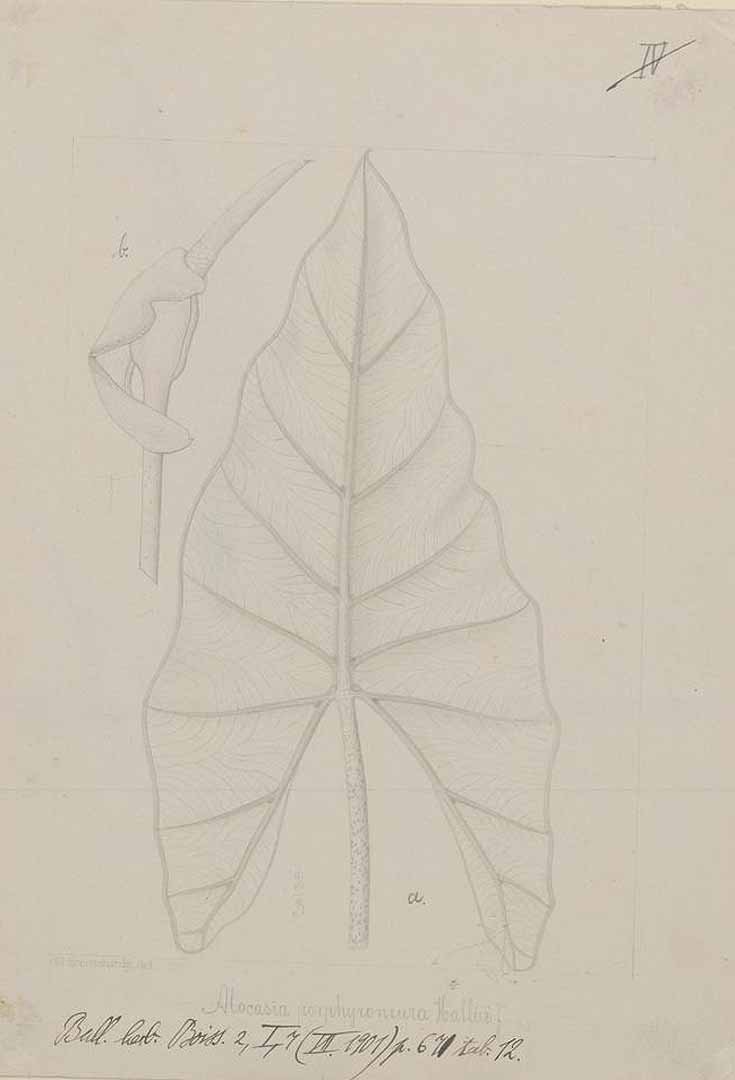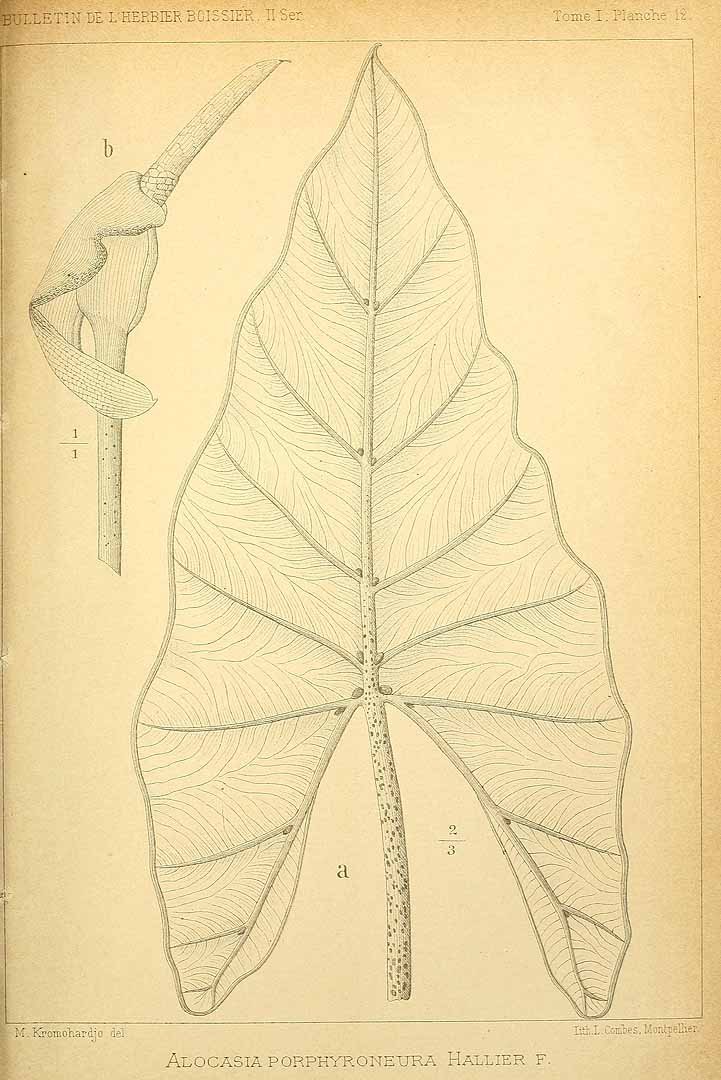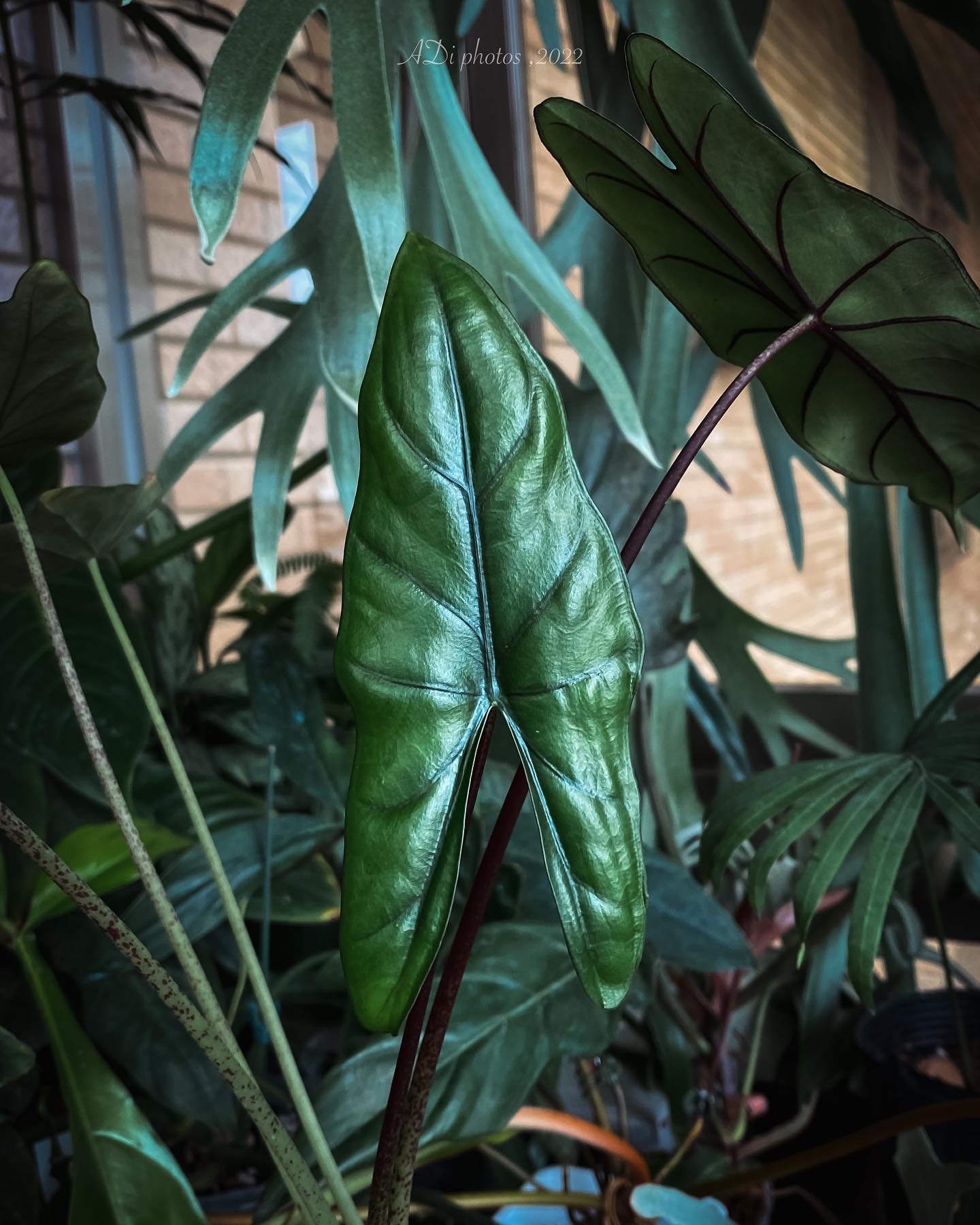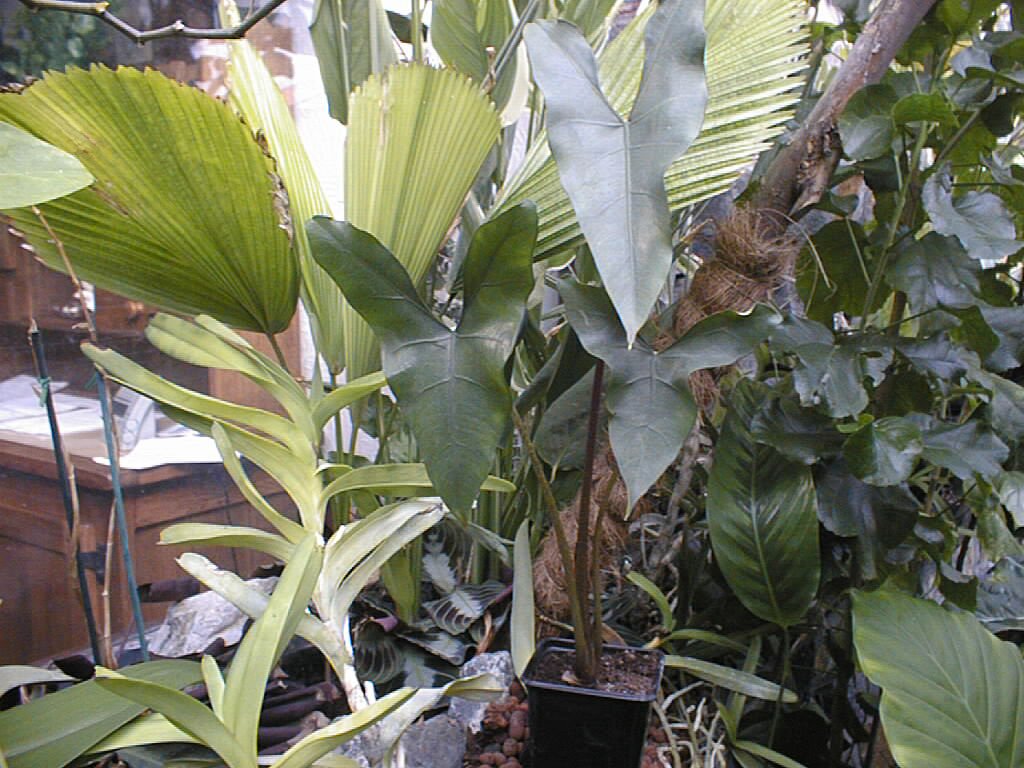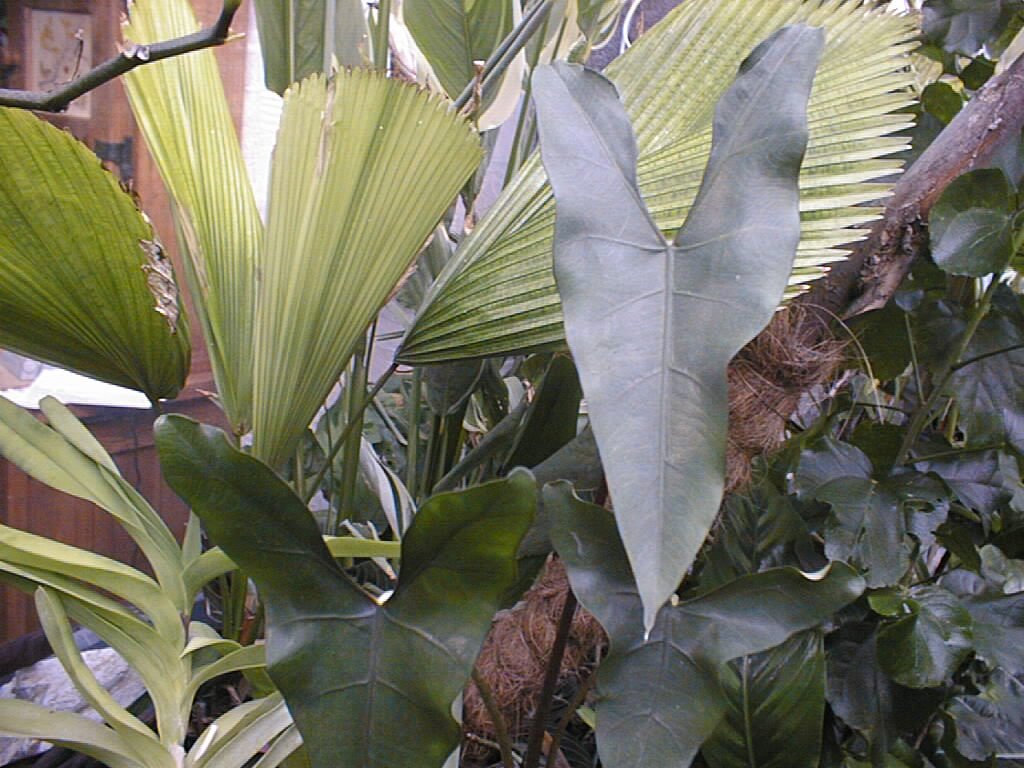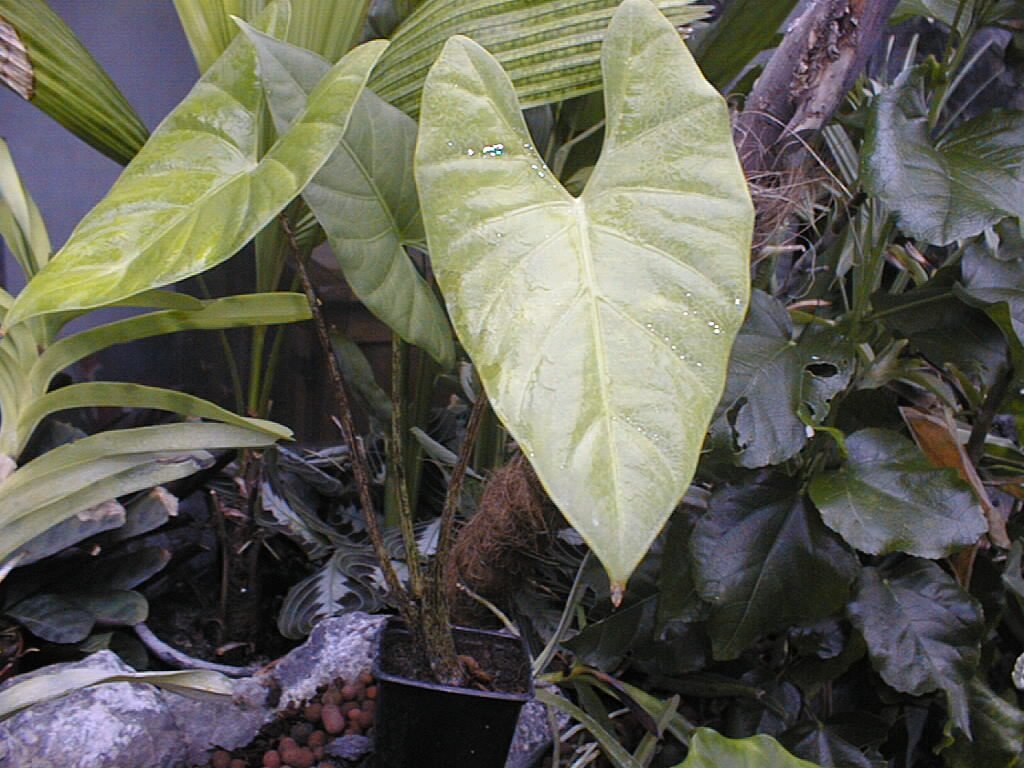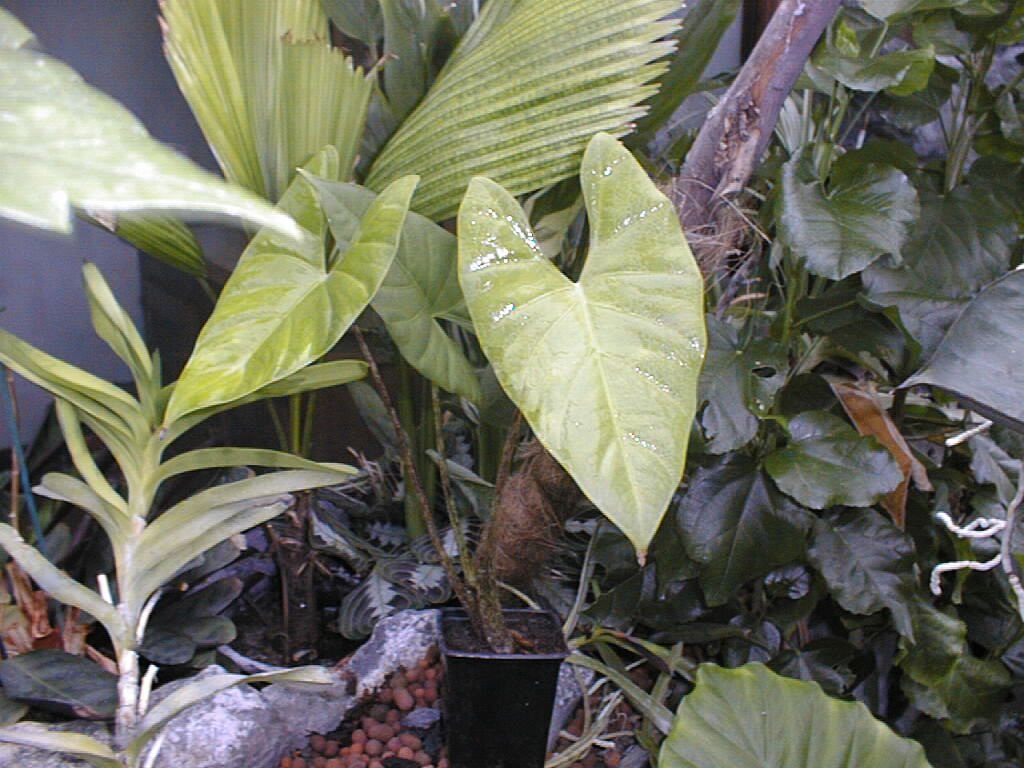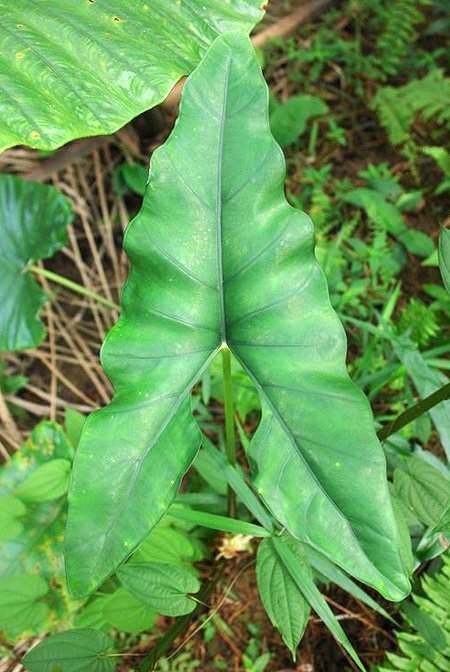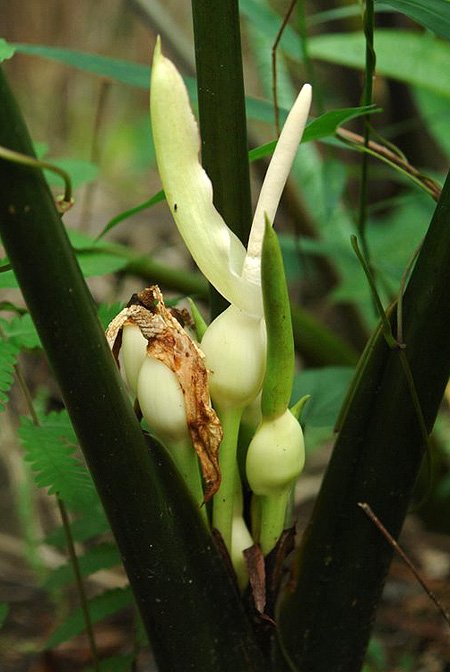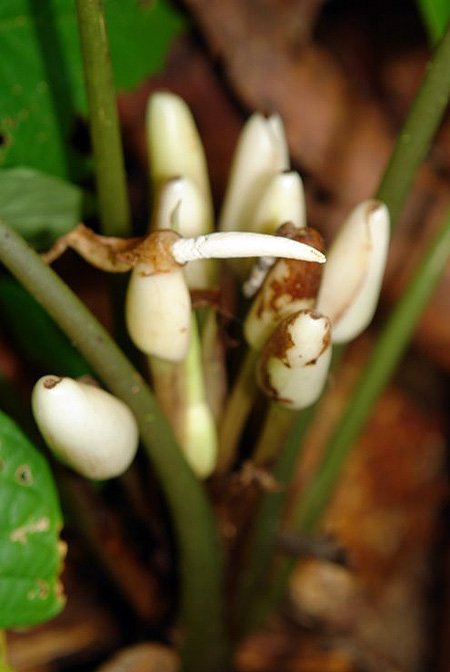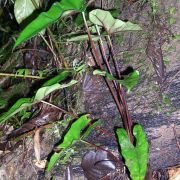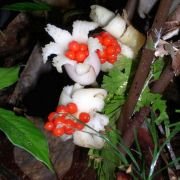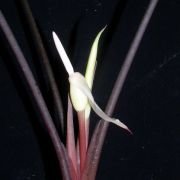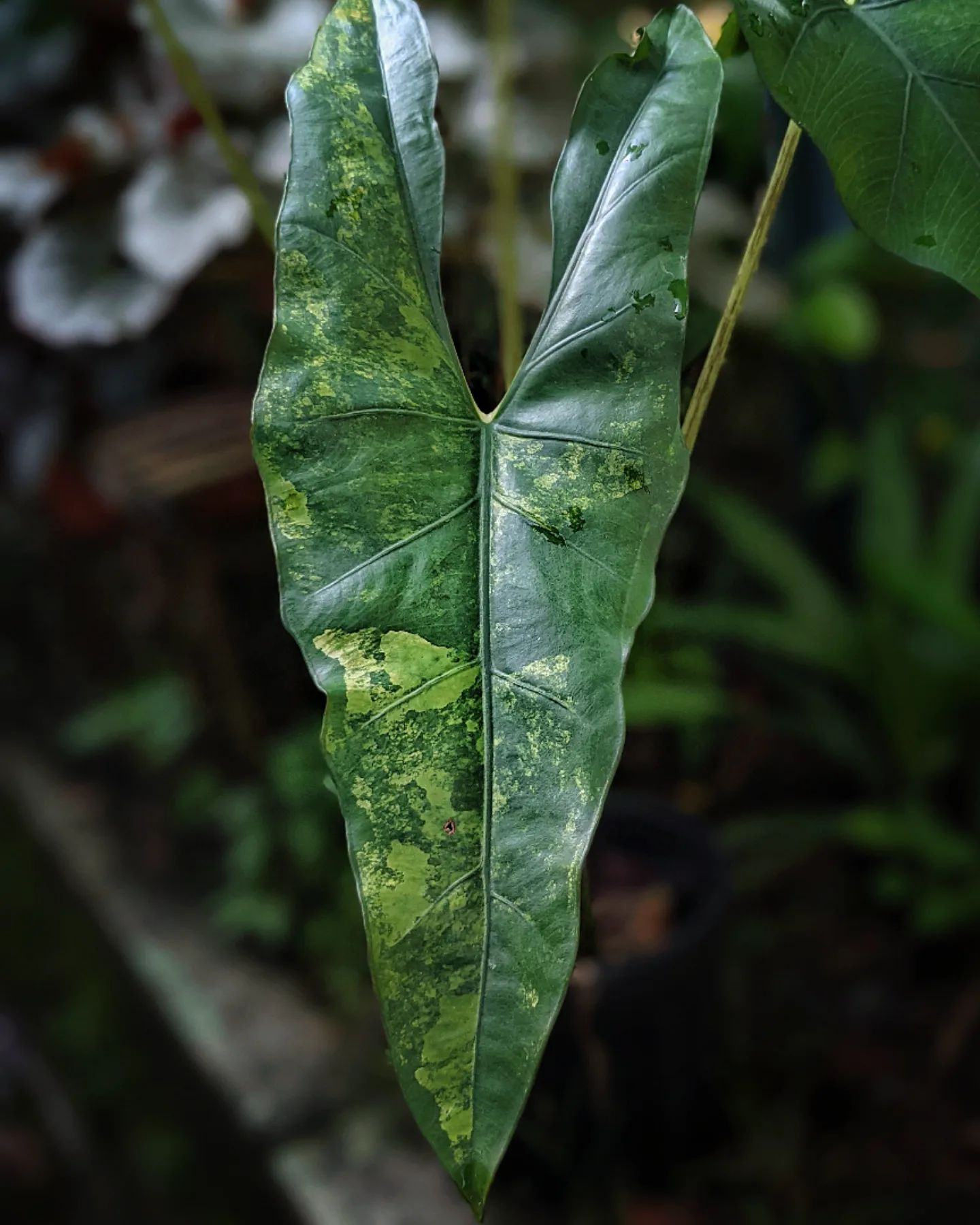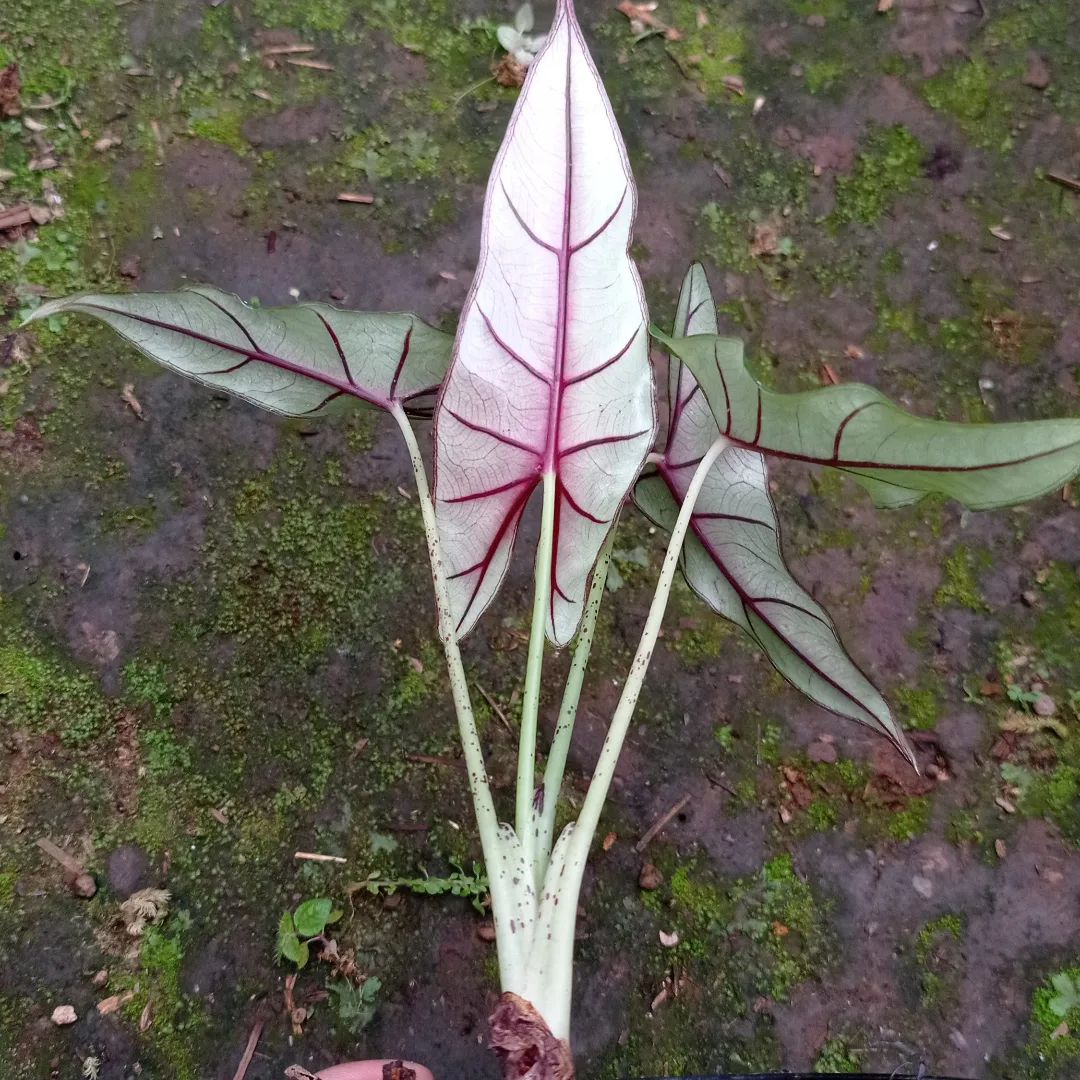ALOCASIA PRINCEPS
Photo by Pokok Man
SYNONYMS: Alocasia porphyroneura Hallier f.
DISTRIBUTION: Endemic to Borneo, where it is wide-spread and common
CLIMATE: Tropical humid climate
Humidity is moderate throughout the year, ranging from 60% to 70%
Temperature is varies between the seasons - within the range of 48°F/9°C to 88°F/31°C during the day. Minimum temperatures never dip below 45°F/7°C
Rainy and humid season (October to May) and a dry season between June and October. The average annual rainfall is 1,200 mm
ECOLOGY: In rain forest generally on well-drained slopes and ridgetops, on a variety of substrates including basalt and limestone, from more-or-less sea level to ca. 1200 m altitude.
SPECIES DESCRIPTION:
Robust to very robust herb ca. 0.8-1.8 m tall; rhizome ca. 5-10 cm diam.; leaves ca. 4 together; petioles suberect, to ca. 1.6 m long, sheathing in the lower 1/4-1/3, smooth to shghtly rough but not scabrid, dark brownish green, very faintly mottled with an obhque wavy pattern, paler distally, varying to thickly and densely, haphazardly marked with longitudinally aligned purplebrown lines and dots, occasionally with few scattered slightly raised circular glands ca. 2 mm diam.; blade to ca. 55 cm long, leathery but not subsucculent, dark green and shining at least when young, paler and sometimes more or less faintly flushed purple beneath, hastato-sagittate, triangular to narrowly triangular in outline, the margin entire to slightly sinuate and undulate; anterior lobe widest at base; anterior costa with 3(-5) primary lateral veins on each side diverging at ca. 60°, often purple-tinged, with conspicuous axillary glands; secondary venation flush on both surfaces, fine and usually purple-tinged, not or hardly forming interprimary collective veins; posterior lobes subequalling the anterior, narrowly lanceolate to ovate; posterior costae diverging at ca. 90°
INFLORESCENCE:
Inflorescences several (ca. 6) to numerous together, subtended by somewhat leathery marcescent green to pinkish or chocolate brown cataphylls marked similarly to the petioles; spathe white to yellowish ivory, ca. 11 cm long, constricted at ca. 3 cm; lower spathe ovoid, somewhat to densely spotted purple; limb oblong lanceolate, usually with purple margins, occasionally pink-tinged to bright purple throughout, reflexed and rolled back, the tip acuminate for 1-2 cm; spadix ivory throughout or the female zone very pale green, distal parts sometimes suffused rose, very shortly stipitate for ca. 2 mm, ca. 8 cm long; female zone ca. 1.5 cm long, subcylindric, ca. 1 cm diam.; ovaries subglobose, ca. 1.5 mm diam.; style ca. 0.5 mm, slender; stigma mostly bi-lobed, yellowing in spirit; interstice ca. 5 mm long, shghtly attenuate, ca. 4 mm diam.; synandrodia lax and ca. 1 mm diam. in the lower 2 mm, the remainder 2-3 dense whorls of more or less rhombohexagonal synandrodia; male zone ca. 2 cm long, 1/2 within the lower spathe chamber, subcylindric, somewhat constricted level with the spathe constriction, ca. 5 mm diam.; synandria rhombohexagonal, ca. 1-2 mm diam. (larger in the lower part of the zone), ivory; appendix 3.5-4 cm long, slightly narrower than the male zone, 4-5 mm diam., tapering gradually to a point, ivory to flushed pink; fruiting peduncle to ca. 20 cm long; fruiting spathe broadly ovoid, ca. 3-4 cm diam, white, sometimes spotted purple.
VARIEGATED FORMS: MOTTLED
ETYMOLOGY: Named after the Latin princeps word meaning "first in time or order; the first, foremost, chief, the most eminent, distinguished, or noble; the first man, first person"
NOTES:
1. Alocasia princeps was described from a sterile plant from 'the Malay Archipelago' in an 1888 retail horticultural catalogue produced by the British nurseryman William Bull. The description is by no means exhaustive, but nevertheless is quite detailed about leaf texture, shape and color, and it does not seem to fit anything other than the species defined here. The following year the description appeared in Kew Bulletin, very slightly re-worded, in an anonymously compiled hst of the previous year's new plants. Since N.E. Brown was the aroid authority at Kew at the time, it seems quite probable that he contributed at least those plants to that list, if not compiled the list entirely himself. Halher (loc. cit.) had seen A. princeps growing at Kew (though not until 1897) and considered it the same as his Alocasia porphyroneura. Hallier evidently did not think Alocasia princeps had been properly published, but since it had been, and since he placed it, albeit attributed to Brown and not Bull, in the synonymy of Alocasia porphyroneura, I conclude that the latter is superfluous.
Although Brown usually preserved material of new aroids in cultivation at Kew, no identifiably original material nor illustration exists, which fixes the application of Alocasia princeps or can directly assist in its interpretation. The leaf is described as having 'deeply sinuate' margins, which is extreme for this species, in which the leaf margin is usually more or less entire, sometimes somewhat undulate and occasionally shallowly sinuate (Hallier described the leaf margin of Alocasia porphyroneura as repand-sinuate and strongly undulate, which fits better the states I have observed).
However, 'deeply sinuate' is perhaps open to a variety of interpretations, and the state may even have been somewhat exaggerated by Bull for marketing purposes. Although, as has been said, there is no original material bearing this name at Kew, a sterile specimen nevertheless exists there obtained from Bull, allegedly originating from the Philippines, dated Aug 11 1887 and with Bull's number 4454/5. It is simply annotated 'Alocasia' in Brown's hand. It matches Bull's catalogue description of Alocasia princeps closely (except that the leaf margin is shallowly sinuate), and is clearly not Philippine, conforming exactly to Alocasia princeps in the sense here. It seems likely that this specimen is from the original plant Bull introduced and perhaps only subsequently called Alocasia princeps.
Since Hallier had seen what is presumed to be the original plant and considered it the same as A. porphyroneura, which he had described in considerable detail and of which he had preserved material, I consider that A. princeps should be neotypified accordingly. This interpretation is to some extent further supported by the only preserved material I have come across originally annotated with this name: a plant cultivated at the Peradeniya Gardens, Ceylon, collected by Alston in 1926 (Alston 794, K!) and which clearly falls within the present concept of Alocasia princeps. The designated neotype collection is one of few that is fertile, of known wild provenance, and that exists in duplicate.
Other specimens seen: SARAWAK: Belong, Saribas F.R., Anderson 8507 (L); Hose Mts, Mujong, Ulu Temalad, Ashton S17639 (L); Simpang Tiga, Ulu Mayeng, Kabu, Chai S19219 (US); Baram Distr., G. Api foothills, Chew 1099 (GH, K, SING); Lingga, Hullett s.n. (SING); 4th Div., Garden of Eden, Mulu National Park, Primack S42403 (K). BRUNEI: Temburong Distr., Sg. Temburong at Kuala Belalong, Boyce et al. 384A (K); Temburong, headwaters of Sg. Temburong to NE Guning Retak, Johns 6733 (K); Temburong Prov., Batu Apoi F.R., Sg. Belalong, Poulsen 18 (K); Temburong Prov., Batu Apoi F.R., Sg. Enkiang, Poulsen 264 (K). SABAH: Kudat Distr., Pulau Balembangan, NE inner side of Telok Lung, BCS-EFA-LM et al. (sic) SAN 86716 (L); Mt Kinabalu, Ulu Liwagu and Ulu Mesilau, Chew et al. 1954 (K, SING); Mt Kinabalu, Dallas, Clemens & Clemens 26134 (BO) & 26268 (BM, SING); Penibukan, Clemens & Clemens 30519 (BM, SING) & 31161 (BM, K, SING) & 32095 (BM, BO, GH, L, SING); Mabul Isl., Creagh s.n. (K); Moyog, along rd Kota Kinabalu-Tambunan, 24 mi SE of Kota Kinabalu, Croat 53102 (MO); Kinabatangan Besar, Kori Timber Camp, Cuadra A2153 (BO, K, KEP, L, SING); Nungkok Mt, Darnton 443 (BM); Kinabalu, Tenompok, Clemens & Clemens 29148 (BM, BO, GH, K, L) & 29149 (BM, SING) & 29150 (SING) ); Cult. RBG Kew EN 441-63 ex Sapong estate, nr Tenom, Giles & Woolliams s.n. (K); Cult. RBG Sydney Acc. No.950357 ex Kinabatangan, Gua Batu Puteh, Hay et al. 10015 (NSW; fertile voucher SAN); Cult. RBG Sydney Acc. No. 960560 ex 2.5 km above main Mahau Falls, G. Rara F.R., Hay et al. 12039 (NSW). Cult. RBG Sydney Acc. No. 960467 ex Tibau Forest Station, Kinabatangan, Hay et al. 12140 (NSW):' Lahad Datu. Selangan Island F.R., Semporna, Keith A1519 (K, KEP, L) & 7658 (SING) & 9281 (KEP, SING) & 9286 (KEP); Bajau, Mt Sidungol, Keith 9295 (K, KEP, SING) Keringau Distr., Camp C area Tiulan, Maikin Lantoh 102054 (K); Ranau, ca. 3 mi NW of Kg Pinawanti. SAN 76856 (K). KALIMANTAN: Sungei Utung, Amdjah 356 (BO); East Kalimantan, Balikpapan, PT. ITCI area, Darnaedi 431 (BO); Kalimantan Selatan, G. Halauhalau (G. Besar), Pegunungan Meratus, Barabai, Dransfield 2870 (BO); Kalimantan Selatan, Djaro Dam, Muara Uja, Dransfield & Saerudin 2210 (BO) & 2217 {BO)\ Kalimantan Selatan, 2km S of Djaro Dam, Muara Uja, Dransfield & Saerudin 2296 (BO); Central East Borneo, W. Koetai, Endert 2702 (BO, L); Cult. Hort. Bogor, Hallier s.n. (BO); Lombok Utan, Hallier 358 (BO, L); Amai Ambit, Hallier 3455 (BO); East Kalimantan, Loa Haur, W of Samarinda, Kostermans 6810 (BO, K); East Kalimantan, Nanukan Island, Kostermans 8784 (BO); Kutei, G. Beratus, piek van Balikpapan, Meijer 653 (BO); East Kalimantan, Nunukan, N of Tarakau, Meijer 2033 (BO) & 2168 (BO) & 2300 (BO)
CULTIVARS: Alocasia princeps ‘Candy Sticks’, Alocasia princeps ‘Purple Cloak’
HYBRIDS: Alocasia ‘Sumo’ (Alocasia ‘Portora’ x Alocasia princeps)




